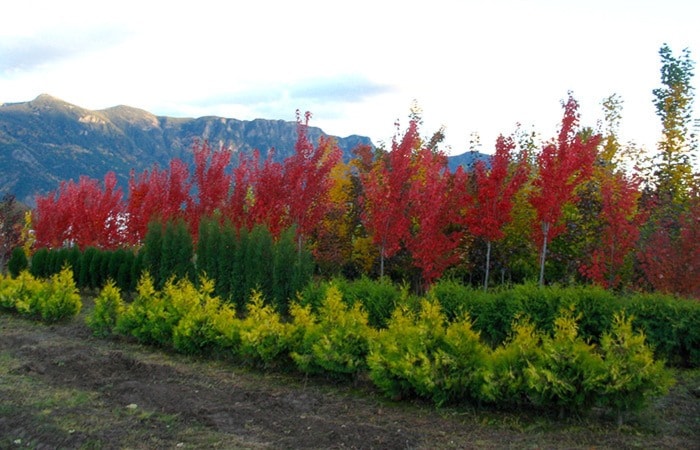I was asked by some of the folks in the Creston Valley Garden Club to shed some light on what we do here at the farm in order to prepare the nursery and gardens for winter. In short, a variety of activities and it takes several months to do it starting the last 10 days of August.
When the cherry harvest is done I take a week-and-a-half off. This means the orchard, gardens and field grown nursery stock gets a little casual drought stress. This begins the shutdown for winter. All the potted nursery stock is still watered by staff as needed. Upon return, the farm gets a weekly watering until freeze-up. Nighttime temperatures drop and day lengths get shorter. The leaves on the trees begin to change colour. Many insects and mites will also begin going dormant for winter. You want to eliminate them while you can. While a short-term dry spell will help to initiate a winter dormancy, plant cells need to go into winter well hydrated. Plants that had a rough summer will have an even worse time over winter if they go into winter dry.
September is the time to reduce the pest and disease inoculums for next year. I sprayed the orchard and nursery with sulphur in order to control any mites and fungal disease. Later, when the leaves have fallen off the trees, they can be sprayed again with copper to control any bacterial blights. In the case of peaches and nectarines, copper controls a fungal disease peach leaf curl. Any buggy apple fruit is sent to the dump.
Short grass encourages the deer to feed elsewhere over winter. So will a deer repellant. The lawns are mowed and the grass and leaves composted, with the exception of the walnut leaves. Other plant debris is added to the compost piles. The perennials are cut back and cleaned up for next season. Small plants are shifted up a container size.
Roses are mulched at the base of the plant and pruned back by one-third. If left full-size, they can sometimes be blown around by the wind and this allows the cold to damage the graft. They will be re-pruned again in spring.
Where possible, the nursery gets one more weeding, either by hand or by use of chemicals in the field. Fall is the perfect time of year to apply pre-emergent herbicide to the field stock for next year.
We move all of the potted nursery stock inside the greenhouses for winter. Larger potted stock that is too big for the greenhouse is placed pot-to-pot (outside) and surrounded by a sawdust mulch. In warmer winters the mice just love this so around the nursery we need to help the cat, Sugar, out with the mouse control. I place bait stations out where I deem them necessary and safe for the pets.
If we have a really mild winter with lots of precipitation, the copper sprays will need to be reapplied. Late in spring most of the fruit trees will be treated with a lime-sulphur and dormant oil spray.
Before the nighttime temperatures reach -5C, all of the seasonal waterlines are drained and then blown out with compressed air. We have a lot of underground waterlines and several seasonal buildings so this is quite the process. Experience has shown that this is time well spent. The bathrooms then have an RV antifreeze added to all of the toilets, sinks and drains. All of the eight sprayers get the same treatment. Water or pond pumps must be drained. Aluminum water pipes are collected up and labeled as to where they will need to go back to in the spring. If I can put any machinery into sheltered space, I do so. Pesticides are placed under the nursery building so as to prevent damage from freezing. Same with any frost tender bulbs that might be on hand.
Out back in the gardens, any special seedlings are collected along with containers of seed from certain other plants. This is processed and sown in flats over the winter to break dormancy. This year we made a special effort in the gardens to reduce pest populations for next year. We actually cut out a bunch of wild bushes and incinerated them. Elsewhere pallets are moved to make plowing snow easier.
Nursery and greenhouse mix is moved inside so it will be easy to get at in January. There really is nothing like packing several tons of frozen potting soil over to the furnace room in January to thaw out before taking it over to the potting bench at the other end of the greenhouse. Speaking of furnaces, I like to relight them when the weather isn’t so cold, so I do that now and not when it hits -15C.
Fall is also the time to complete inventories, reorder where necessary and start planning for spring. If possible, the cherry orchard is pruned before Christmas. It may not be the perfect time of year to do it but that’s where it fits into the schedule best.
So that’s fall at the nursery!
Evan Davies owns Beltane Nursery in Erickson.
